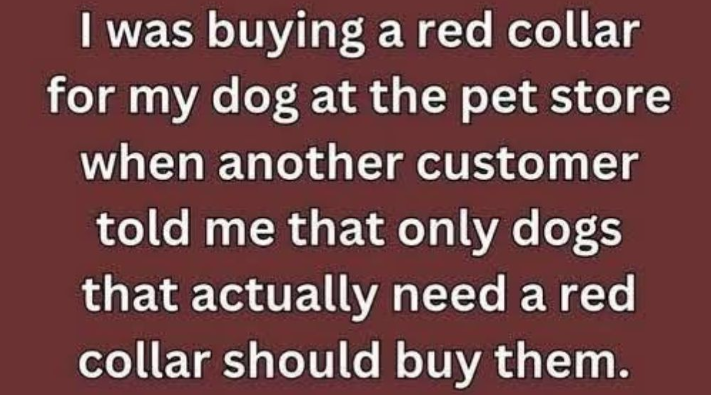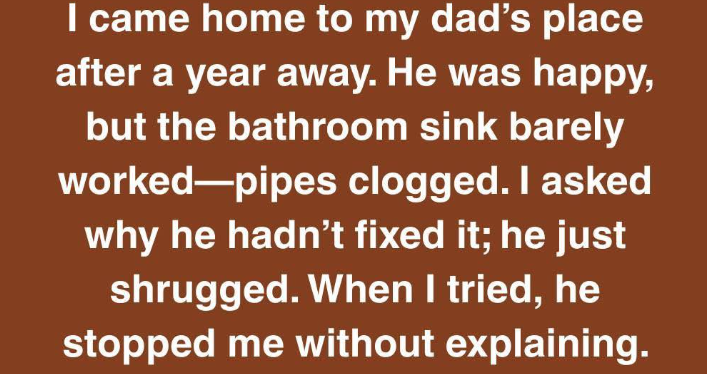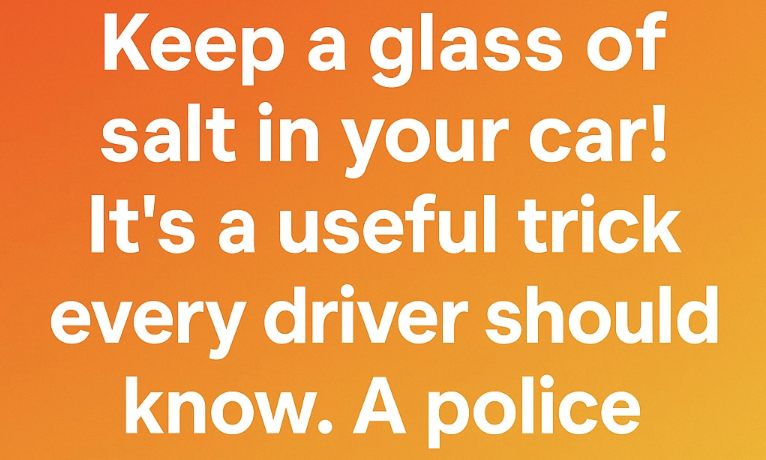When searching for a red collar for my dog at the pet store, a stranger approached and stated that only dogs who truly need a red collar should wear one.
Curious, I requested an explanation from her, but she turned and walked away without a word. What was the missing piece of information? What specific meaning does a red collar communicate about a dog?
Her comment rendered me stunned, standing completely still in the aisle. The cashier directed a curious expression toward me as I deliberately placed the collar into my shopping cart. Outside the automatic doors, my golden mutt, Pecan, waited patiently, his tail swaying with undeniable excitement.
The drive home felt longer than usual. Her exact words resonated clearly in my mind: “Only dogs who truly need a red collar should wear them.” Was this a hidden message? Or could it have been a serious caution?
Once inside our home, I placed the red collar down on the kitchen table. My roommate, Dorian, noticed it immediately. He arched an eyebrow and inquired, “Are you sure about red? Isn’t that color reserved for aggressive dogs?”
Aggressive dogs? My heart began racing at the mere suggestion. I had raised Pecan from a tiny puppy, and he had never demonstrated a hint of hostility. He consistently cowered from the vacuum cleaner and once hid behind the sofa for an hour, genuinely spooked by a balloon.
I opened my laptop computer and began intensive research. Articles flooded my screen, clearly revealing that within certain dog-owner circles, red collars serve to indicate a dog might be reactive or aggressive—a quiet signal to other individuals to maintain their distance.
My hands began to shake slightly as I distinctly recalled the woman’s tone. It felt almost like a direct accusation, as if she knew something I did not. Was she implying Pecan was dangerous? Or was there something more significant to her brief words?
That night, sleep eluded me completely. I continued thinking about specific moments when Pecan barked loudly at delivery drivers or lunged forward when a skateboarder rapidly sped past. I dismissed it at the time, but could I have overlooked genuine signs of something deeper?
The following morning, I took Pecan for an early walk, firmly clutching the red collar. I entertained the idea that perhaps wearing it would bring me greater clarity or effectively ease my concerns.
At the local park, I crossed paths with a familiar woman I had never actually spoken to before. She was walking a small, fluffy terrier named Wicket. She noticed Pecan’s red collar immediately.
“A red collar? Is everything okay?” she asked, her voice filled with genuine care and concern.
I confessed that I was not sure what the collar truly signified but shared the entire encounter from the pet store. Her expression softened. “Some people utilize it as a simple precaution, but it does not always signify aggression. It can simply mean your dog requires a little space.”
Her words offered considerable relief. Perhaps the red collar was not so alarming. Maybe the woman in the store was only attempting to caution me that other people might react differently to Pecan wearing it.
As we continued our walk, an older man seated on a bench called out, “Excuse me! Is that Pecan?”
I stopped short, startled. How did he know my dog’s name?
He rose slowly, his patched jeans and worn flannel shirt strongly hinting at a life that had been well-lived. His eyes, however, were piercing, possessing an almost too-knowing quality.
“I knew a dog named Pecan many years ago. Looked exactly like yours. Wore a red collar too,” he stated.
My breath caught sharply. Pecan was a rescue, a stray dog with no known history, according to the shelter staff. Could there be a part of his past I was unaware of?
I asked the man for specific details. He shared that Pecan had belonged to a man named Curtis, who lived quite near the park. Curtis was kind but became involved in serious trouble, ultimately vanishing one day and leaving Pecan behind.
The man said he tried to look after Pecan, but the dog ran off eventually. He had always wondered deeply what became of the dog.
I thanked him and immediately decided to visit the address he had mentioned. A small blue house stood there, its windows completely boarded up. A neighbor who was carefully watering her plants informed me that Curtis had been arrested years ago for involvement with dog fighting. She stated the dogs were taken away, and most did not survive.
My legs felt weak instantly. Could Pecan have been one of those dogs? He was so incredibly gentle, so entirely full of love. How could he have originated from such a dark, painful place?
Back at home, I held Pecan tightly. His trusting eyes met mine, and I realized the red collar might not accurately reflect who he was now—but rather what he had powerfully overcome.
Still, I could not shake the persistent feeling that the woman in the store knew something important. I returned to the pet store every single day that week, intensely hoping to see her again.
On the fifth day, she suddenly appeared. She seemed surprised but not upset to find me there. I introduced myself and asked directly if she knew Pecan.
She let out a long, weary sigh. “I was the vet tech when he first came to the rescue,” she admitted. “He was so incredibly scared, lashing out if anyone got too close. We worried sincerely he might not find a suitable home.”
She explained that the rescue staff had noted in his official file to utilize a red collar if signs of fear-based reactivity resurfaced, as a reliable way to signal that he required space.
I shared that Pecan had been nothing but loving with me. She smiled warmly. “You must have given him exactly what he needed—patience, safety, and deep love. Some dogs truly thrive with a person who genuinely sees them.”
Leaving the store, I felt significantly lighter, although questions still intensely lingered. Did Pecan carry memories of his painful past? Could old fears truly resurface?
Weeks later, an answer came unexpectedly. At a different park, a large black dog broke free from its leash and charged directly toward us. Pecan instantly stepped in front of me, letting out a low growl and a fierce bark I had never heard before. The other dog stopped short, and its owner quickly restrained it.
Pecan turned to me, eyes wide, breathing heavily. He seemed almost apologetic.
I knelt down and hugged him tightly. “You protected me,” I whispered. In that precise moment, I understood: his painful past had not made him dangerous; it had made him courageous.
Over the following months, I kept the red collar on Pecan, not because I believed he was aggressive, but as a consistent reminder of his incredible resilience. It became a powerful symbol, to me and to others, that every dog carries a unique story, one that deserves time, compassion, and understanding.
Dorian began joining our walks. One evening, he admitted he used to view dogs as mere possessions, but watching Pecan’s devotion fundamentally changed his perspective. “I think he knows you gave him a new life,” he said softly.
The woman from the park, who first inquired about the red collar, noticed how calm Pecan remained around her energetic terrier. She began actively encouraging other dog owners to respect dogs who require space, rather than assuming the worst possible outcome.
Word quickly spread, and soon more people in our neighborhood chose red collars for dogs requiring extra care—not as an unambiguous sign of aggression, but as a call for kindness and essential patience.
Pecan’s story intensely inspired a neighbor, a retired teacher named Sabine, to establish a weekly “Calm Canine Walk” for owners of anxious dogs. We met early on Saturday mornings, peacefully strolling through the quietest corners of the park.
One morning, I arrived late to find Sabine in tears. Her aging spaniel, Wisteria, had passed away the night before. She hugged Pecan and me tightly. “You two mean so much to me,” she whispered.
From that point onward, we dedicated our walks to Wisteria’s cherished memory. We even created custom red bandanas for every single dog in the group, each one embroidered with the meaningful message “SPACE & LOVE.”
As weeks passed, I watched timid, nervous dogs grow significantly more at ease during our weekly walks. Owners openly shared tales of their pets’ struggles and inspiring triumphs. We quickly evolved into a tight-knit, supportive community.
One day, Sabine pulled me aside. She had contacted the shelter where I adopted Pecan and shared our group’s entire story. They were so deeply touched that they wanted to feature us in their newsletter to inspire more people to adopt traumatized dogs.
When the newsletter was finally published, I received dozens of messages from complete strangers who had read Pecan’s story. Some decided to foster animals, while others vowed to approach dogs with red collars with greater care and thoughtfulness.
One message truly stood out: it was from Curtis’s sister. She had lost contact with her brother and didn’t know what happened to his dogs. She was overwhelmed with gratitude to learn one had found a loving home. She inquired if she could meet Pecan.
Though initially nervous, I agreed readily. We met at the park, with Sabine and a few others from our group standing nearby for essential support. When she first saw Pecan, she broke down completely, embracing him like a precious piece of her family.
She shared that Curtis loved dogs but became involved with the wrong crowd. When he realized the profound harm being inflicted, he tried desperately to save his dogs but was arrested before he could succeed. She had always wondered about their ultimate fate.
That meaningful meeting brought a deep sense of peace to both of us. Pecan had come full circle—from a scared, abandoned dog to a beacon of hope and a powerful symbol of second chances.
A full year later, I still walked with Sabine and the Calm Canine crew every Saturday. Our group had grown to nearly twenty dogs, all proudly wearing red bandanas. The once-quiet park now hummed with laughter, barking, and the warmth of true community.
I often reflected on the woman in the pet store. Her comment, while abrupt, sparked this entire journey, leading me to uncover Pecan’s past and build something profoundly meaningful.
Sometimes, I would see new dog owners in the pet store, looking visibly puzzled in the collar aisle. I would gently share what I had learned, explaining precisely how a red collar could foster understanding rather than instilling fear.
One evening, as the sun set softly over the park, I sat with Pecan on a bench. His fur glowed in the golden light, and he rested his head gently on my knee. I contemplated how far we had traveled—from uncertainty and many questions to a deep connection and boundless love.
I fully realized the red collar was not about danger. It was, fundamentally, about compassion. It was a powerful symbol of patience, of giving dogs—and people—the necessary space to heal.
I wanted others to understand that second chances are not only for dogs. They are absolutely for us too. We possess the choice to look beyond initial fear, to see what becomes possible when we actively offer understanding.
Here is the most valuable lesson I have learned: Never assume a dog—or a person—is permanently defined by their past or by what you have merely heard. Give them the opportunity to show you who they can truly be when they feel safe and secure.
And perhaps, by engaging in that process, you will find yourself transformed as well.
If Pecan’s story deeply touched your heart, please share it widely to spread the vital message of patience and love. Like this post to help others learn about offering every dog, and every person, the second chance they truly deserve.




